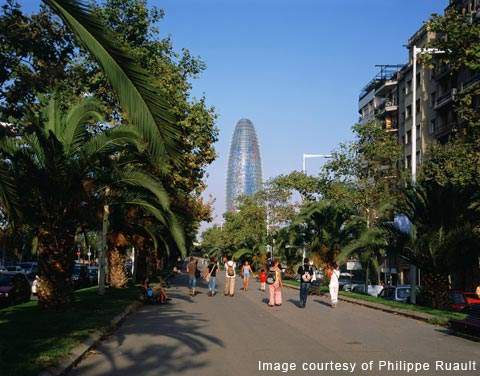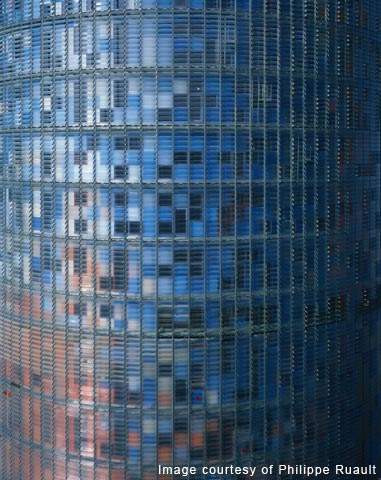The Agbar Tower or Torre Agbar is a 21st-century skyscraper at Plaça de les Glòries Catalanes, Barcelona, Spain. It was designed by French architecture firm Atelier Jean Nouvel in collaboration with the Spanish b720 Arquitectos, led by Fermín Vázquez.
The 142m-high tower is the third-tallest building in Barcelona and home to the offices of its owner the Agbar Group, which is the holding company of Barcelona water company – Aguas de Barcelona (AGBAR). Construction of Torre Agbar started in 2001 and the tower was completed in July 2005.
One of the most unique features of the Torre Agbar is its conceptual design and the integration of the sustainability values of bioclimatic architecture. As well as its size, the bullet-shaped tower, is characterised by its ability to provide exceptional symbolic value to the business district of Barcelona – 22@ district. Around 1,174 professionals and operators worked towards preparing the site and building the tower.
Torre Agbar concept and design
Agbar Tower was jointly designed by Jean Nouvel and b720 Arquitectos, led by Fermín Vázquez. The architectural design of the tower was inspired by the land, nature and architectural legacy of Antoni Gaudí and the hills of Montserrat.
Nouvel says: “Unlike slender spires and bell towers that typically pierce the horizons of horizontal cities, this tower is a fluid mass that bursts through the ground like a geyser under permanent, calculated pressure.”
The 38-storey tower has two non-concentric oval cylinders crowned by a glass and steel dome. There are 34 spacious floors above ground – 28 floors for office use, three technical floors to centralise installations, one floor for the cafeteria, one for multipurpose rooms and one for a bird’s-eye view in the tower’s dome.
The building has four floors below ground level – two floors for a 316-seat auditorium and two for parking. There are 11 elevators in total, including one service elevator and two for the underground floors.
Bioclimatic architecture
Torre Agbar employs bioclimatic architecture, which adapts according to the environment and, by minimal contamination of the environment, is sensitive to its impact on nature. This type of architecture uses the surrounding climate and conditions to reduce energy consumption and enhance the environment for the building’s users.
Torre Agbar has 4,500 windows to maximise natural ventilation and reduce energy costs by optimising sunlight usage. One of the key features of the tower is its nocturnal illumination. It uses 4,500 RGB LED luminous devices that are computer-controlled and help generate luminous images in the façade. Energy consumption for air conditioning is reduced through the temperature sensors on the exterior of the tower that regulate the opening and closing of the glass blinds of the façade of the building.
Regulation of air flow and natural ventilation is increased through double glazing in the dome. This also helps reduce the temperature of the building because of the chamber of air formed between the two skins.
Elevator routes have been optimised through computer systems to prevent unnecessary consumption. The energy gain to incident solar radiation proportion touches an average of 25.11%. Materials containing formaldehyde, asbestos or lead, especially in paints, have been avoided. Coolant glasses that do not contain CFCs have been used to avoid ozone depletion.
Agbar Tower interior
The Torre Agbar has a broad entrance lobby and the office area is spacious and free of columns. The interior has a false ceiling of galvanised steel plate, which is sound proof. There are lights embedded into the ceiling and down-lighting is provided in areas of traffic and elevator access.
Space is efficiently utilised with the adoption of an open-plan interior with no internal pillars. The interior design of the Torre Agbar is in sync with the energy and colour of its exterior. Glassed-in offices, fixed and tilting windows, modular furniture, and a lighting system using presence detectors and remote control through infrared are the unique features associated with the interiors.
The false ceiling has sprinklers and emergency circuits and centralised fire detection systems.
Design excellence
The Agbar Tower won the 2006 Awards for Excellence organised by the Urban Land Institute (ULI) in both the European edition and the world edition.
The recognition was given as an appreciation for its design, its significant role in the development of the new 22@ district in Barcelona, efficient land use, its sensitivity towards society and the environment and the economic and financial success it has achieved.
The Torre Agbar has also won another important award – the 2006 International Highrise Award. The award is organised by the City of Frankfurt and DekaBank in affiliation with the Deutsches Architektur Museum (DAM).





